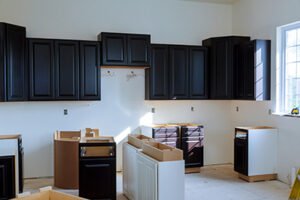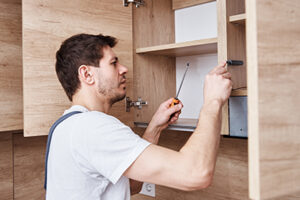How to Mount Kitchen Cabinets to the Walls
Every homeowner has most likely dealt with a kitchen renovation once in their life, and mounting cabinets to the walls is a big part of the process. After my recent kitchen renovation, it was evident that this task required some research and trial and error. After the project was completed, I have compiled the best tips for mounting kitchen cabinets!
What is the best tip for mounting cabinets to kitchen walls? The best tip when mounting cabinets to kitchen walls is to read the instructions that come with your cabinet mounting systems carefully. These instructions are usually very simple, but make a huge difference in mounting kitchen cabinets properly. I found the mounting systems to be simple and effective but required a little more work compared to other mounting systems.
Although mounting kitchen cabinets might be an easy task to some, it can prove to be difficult if you don’t have the right system put into place. Make sure to keep reading and learn about these helpful tips during your kitchen renovation!
7 Tips to Follow When Mounting Kitchen Cabinets
Mounting cabinets is not a difficult task, but I found it to be something that needs to be done carefully and with the proper mounting systems. Here are a few tips to keep in mind when completing your project:
 Tip #1
Tip #1
Use a stud finder on the wall first. This step will ensure the mounting system you choose will be strong enough to handle your cabinets. This step is extremely important and it ensures that your mounting system can handle the weight of your cabinets.
We used medium-sized cabinets, so we chose a medium mounting system, but if you plan on mounting larger cabinets, you might want to make sure your mounting system can handle the weight.
Measure twice and drill once! Make sure when mounting your cabinets that you are using an exact stud in the wall for mounting support. If you mount kitchen cabinets in the same position every time, it will be easier to find a stud every time you want to mount cabinets.
Tip #2
Make sure your mounting system is centered on the wall before drilling mounting holes in the cabinets. If you are mounting kitchen cabinets with three screws around each mounting hole, this step will ensure that your cabinets are mounted evenly and straight to the wall.
Make sure that your mounting holes are equidistant from each other and center them on the mounting system itself.
Tip #3
Be careful about mounting cabinet handles before mounting cabinets to the wall. Before you drill mounting holes for your kitchen cabinets, make sure that your mounting system is securely placed on the wall.
Once you have mounted it onto the wall, be careful with drilling into hands or fingers as they can get caught in between mounting holes. This is especially important if children are present during a renovation like this!
Tip #4
Make sure mounting holes are secured tightly with mounting screws. I made the mistake of mounting kitchen cabinets without tightening mounting screws completely.
Because of this, mounting holes in my cabinets became loose and caused me to have to redo a few parts of my kitchen renovation. Make sure that mounting screws are tight before you mount your cabinets onto wall brackets.
You can always cover mounting holes with a mounting plug too! If you find that mounting holes in kitchen cabinets are large and unsightly, consider placing a mounting plug over the mounting hole.
Simply cut a piece of wood or plastic to fit into the mounting hole and place it securely before mounting your kitchen cabinets onto wall brackets.
 Tip #5
Tip #5
Be careful when mounting cabinets into studs that have wiring in them. If you have a kitchen cabinet mounting system that is centered around wall studs, make sure there isn’t any electrical wiring running through the stud before mounting your cabinets to the wall.
Mounting kitchen cabinets can be dangerous if not done properly and if you mount directly into a stud where electrical wiring is passing through, mounting kitchen cabinets can be extremely dangerous!
Tip #6
Make sure mounting screws are both in studs when mounting cabinets to walls. It’s important that when mounting kitchen cabinets onto wall brackets that you have mounting screws on both sides of the stud to ensure a secure installation.
If there is even a portion of a mounting screw or mounting hole in drywall only instead of in wood, your kitchen cabinet mounting system will not be as secure and it could possibly fall off after time has passed. This step is very crucial when completing a kitchen renovation!
Tip #7
Take your time during the process, especially if you’re doing this alone. Make sure that when mounting cabinets onto wall brackets you do this slowly, especially if mounting cabinets are heavy or large.
If mounting kitchen cabinets is completed carelessly or quickly, mounting holes could be unevenly spread out across your wall which will cause mounting screws to become loose over time. This step of mounting kitchen cabinets is very important!
How Do You Hang Kitchen Cabinets?
The first step is to mark up the wall where the cabinets will be installed. Draw a level line marking how far down you want the cabinets to hang from the ceiling.
Get someone else to hold up your cabinets while you mark where you want them to go on the wall – use a pencil and level, taking measurements as needed.
Once you have the marks made on the wall, take the cabinets off the wall and then take out the door hinges, shelves, etc.
Pre-drill holes into both studs on either side of where your cabinet will be hung, making sure that you leave 1/16th of an inch between each screw. This is how you can hang kitchen cabinets with minimal to no help.
Then you can go ahead and hang your cabinet how you normally would, with the exception of how the cabinets are hanging from the brackets.
You will have to install screws connecting both sides to each stud. This is how to hang kitchen cabinets so they are sturdy enough to hold up heavy dishes and other kitchen necessities.
When you’re finished installing your cabinets, be sure to take a level across the top in order for it to be straight when looking at it from one end in particular.
This is how you can tell if there are any problems or if anything needs to be adjusted in how you hung your kitchen cabinets. Then put all of your door hinges back on, making sure that each door matches how close or far apart they are supposed to based on how much room is between the cabinets.
 Can You Hang Kitchen Cabinets Without Studs?
Can You Hang Kitchen Cabinets Without Studs?
Yes, you can hang kitchen cabinets without studs. This is possible in many situations and with various mounting methods.
The mounting will be much easier when there are already holes in the wall that you can use for mounting. You may prefer to hire a contractor or an interior designer to complete this mounting project if you are not comfortable completing it yourself. However, mounting a cabinet doesn’t have to be difficult.
How Much Weight Can Cabinet Screws Hold?
Cabinet mounting screws are designed to hold a cabinet stable in place against the wall where it is mounted. This may be necessary for the support of heavy objects, or simply so that if they are bumped into by people or other objects, the cabinet doesn’t fall over and become damaged.
The screws are also made to resist coming out of their mounting as a result of such forces.
Cabinet mounting screws are designed to hold weight, but how much is dependent on the type of screw used and mounting conditions. For example, mounting into plasterboard offers far less resistance than mounting into solid brick or concrete. Solid materials should be avoided, and mounting screws should only be used in materials that the screws can pull out of.
As far as how much weight they hold; mounting screws are designed to hold up to 8kg per mounting screw, but this is dependent on mounting conditions such as mounting into plasterboard which would be 3kg per mounting screw.
It also depends on the size of the mounting screw. The larger screws hold more weight but are also more difficult to install. It is usually recommended that mounting screws are no longer than the width of the cabinet is mounted so as not to overload them or cause other problems with installation or mounting conditions.
Recommended sized screws for mounting cabinets are screw size 2.9mm X 16, which can be used for mounting into the plasterboard of a wall only and never into concrete or brick walls
Screw size 3.5mm X 32 should be used in solid materials such as wood, plasterboard, masonry, etc. but not in brick or concrete. They can be used in a stud or flat mounting, but care must be taken to ensure that the mounting screws do not pull out of the mounting material.
In Conclusion
If you’re planning on doing any renovations yourself, mounting kitchens cabinets might seem like a daunting task; don’t give up! With these tips and some patience, I am confident that you will complete this job successfully and have a beautiful kitchen afterward.
If mounting kitchen cabinets is not your specialty, hiring a professional is always an option as well!
